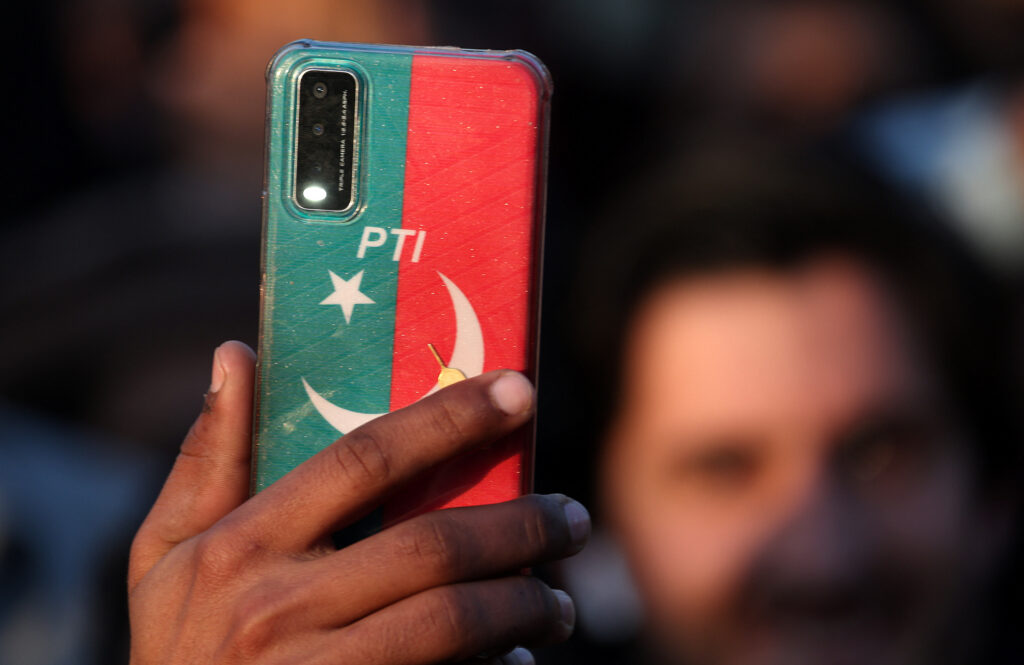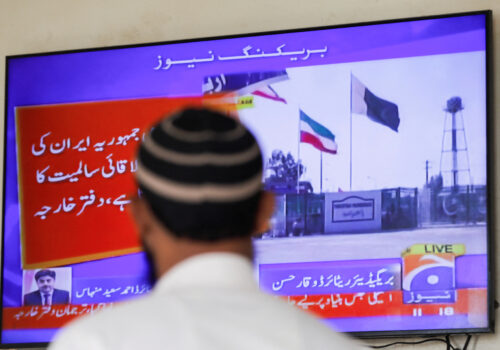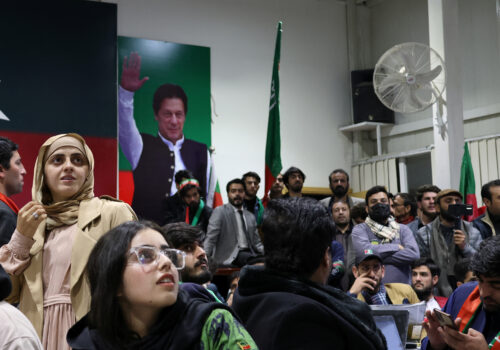Pakistan’s electorate made themselves heard on February 8, when the country held general elections after months of delays. As results came in, it was evident that efforts to curb support for former Prime Minister Imran Khan, who is currently in jail, and his political party fell short on election day. Candidates backed by Pakistan Tehreek-e-Insaf (PTI) emerged as the largest bloc in parliament, winning ninety-three seats (out of 264). On February 13, the two parties that won the second and third largest shares of seats announced that they would form a coalition government, excluding the PTI from power. Nonetheless, the strong result of PTI-affiliated candidates in the election reveals an important trend emerging in Pakistani politics.
Popular anger about sky-high inflation and growing repression, combined with more younger voters entering the fray, did play a key role in the results. But one cannot ignore PTI’s use of technology—much of it not cutting-edge—that not only disrupted the traditional political status quo but also set a new benchmark for electoral campaigns around the world.
Here are five ways in which PTI’s technology and digital media strategy helped the party outmaneuver its rivals in Pakistan’s general elections:
1. Cultivating a culture of bottom-up innovation
Business leaders who have tried to push the adoption of technology in legacy organizations know full well that innovation requires bottom-up support, especially in larger organizations. While PTI’s approach to political engagement has always been fundamentally different from its predecessors, it set itself further apart in this electoral cycle.
The party’s energized base of young supporters have fostered a culture of bottom-up innovation, in which volunteers and supporters feel empowered to take initiative and contribute ideas. This grassroots movement was fueled by digital platforms that allowed for the dissemination of information at an unprecedented scale. When the party’s leaders could not find space on mainstream television, they used Twitter Spaces; when physical rallies were not permitted, they organized virtual jalsas; and when experts with a leaning toward PTI found no space on mainstream talk shows, they took to YouTube.
While some observers rightfully point to how PTI and its affiliated accounts engage in online trolling, harassment, and misinformation, this is only one part of the story. On the other end, this army of volunteers allowed PTI to tap into the collective intelligence of tech-savvy young people eager for change. As a result, despite all sorts of headwinds, the party managed to get the word out ahead of, during, and after the elections.
Examples of this innovation include launching a portal listing its candidates on the online software platform GitHub when the party’s websites were blocked in Pakistan and creating a chatbot linked to Khan’s Facebook Page. PTI also created an open-source repository of electoral data to reinforce its claim that election results had been manipulated.
2. Strategically using artificial intelligence
With Khan in jail and many of its leaders on the run, PTI faced a unique challenge in terms of engaging with constituents across Pakistan. While a traditional media approach would have involved using the written word to get the leadership’s message out, PTI realized that nothing could beat getting Khan’s words out to the masses in his own voice. As a result, PTI embraced the power of artificial intelligence.
Through messages conveyed to his lawyers during meetings, Khan was able to get information out to his party, which then used technology to generate content in his own voice. This ensured that Khan managed to speak virtually to millions of Pakistanis ahead of and after polls. This kept the base energized and ensured that Khan remained in the news cycle, even though he was physically in jail and unable to engage with audiences in a way that other leaders could in the run-up to the elections.
3. Developing peer-to-peer communication networks
With almost 130 million mobile broadband subscribers, Pakistan is undergoing a major digital transformation. Gone are the days in which centralized media skewed citizens’ worldviews. What has emerged in its place are decentralized media and peer-to-peer (P2P) communication, which are changing the way in which citizens consume information and engage with one another.
PTI has historically been a first-mover in this space, but the party took things to the next level during this electoral cycle. Bolstered by a bottom-up media ecosystem leveraging platforms such as YouTube and TikTok, PTI engaged with constituents even though the party was virtually blacked out from mainstream television media.
The party’s cadre of volunteers also harnessed the power of direct messaging apps and platforms to create a network of interconnected supporters. Just days before the elections, a Supreme Court decision banned PTI’s traditional electoral symbol, the cricket bat. Symbols, which appear next to names on ballot papers, are important in a country in which 40 percent of the population is illiterate. In response, the PTI and its volunteers used this network to make sure that voters at each constituency knew who the PTI-aligned candidate was and what their electoral symbol was. This P2P network bypassed traditional media gatekeepers, allowing PTI to control its narrative and engage with voters on a more personal level. A key enabler was WhatsApp, which was leveraged to disseminate campaign materials, information about rallies, and voting instructions directly to the electorate, fostering a sense of community and shared purpose.
4. Dominating the news cycle to earn media
PTI’s technological prowess was not only limited to the digital realm; it also had a profound impact on traditional media. By mastering the art of social media, PTI consistently generated content that was newsworthy, ensuring that the party and its leaders remained at the forefront of the news cycle, even when the party and its leaders could not get direct coverage.
In addition, PTI got stories out into international media, including a piece Khan wrote for the Economist ahead of the elections. In doing so, PTI forced the governing status quo to respond to what the party and its leaders were claiming internationally. This created a whole news cycle in the traditional media, meaning that PTI was being discussed during talk shows, even though the government reportedly banned some news channels from mentioning either the party or Khan. This strategy not only kept PTI in the public eye but also allowed it to shape public sentiment around the fact that the party was being repressed and that there was a risk that the will of the people would not be respected on election day.
5. Opponents failing to innovate
The success of PTI’s technological initiatives was further underscored by the failure of its political opponents to innovate and get a grip on Pakistan’s digital transformation. While PTI was pioneering the use of digital tools for political engagement, other parties remained entrenched in conventional campaign tactics. This reluctance to adapt to the digital age left PTI’s rivals struggling to keep up with the rapid pace of change, rendering their campaign efforts less effective and less resonant with a population increasingly reliant on technology for information and social interaction. In addition, the status quo relied on the traditional tool of blocking access to the internet, which was both ineffective—people could use virtual private networks, or VPNs, to get around the block—and created further conversation about why the state was blocking access to the internet. These tactics only reinforced PTI’s messaging, meaning that it was PTI, not the status quo, shaping the narrative and dominating the headlines.
The result of PTI’s technological campaign strategy was a more engaged and informed electorate, which translated into significant electoral gains. Khan’s PTI managed to galvanize a significant part of the electorate, and the party’s success demonstrates the potential of digital tools to democratize political participation and challenge entrenched power structures.
It is no surprise that some of the most powerful men in Pakistan want to find ways to control the internet. Over the last few years, for example, the government has tried to control the internet by proposing new laws and regulations, some of which have been struck down by the courts. By and large, these efforts have failed to stem the tide. What comes next remains to be seen, and the threat to internet freedoms remains high in Pakistan. PTI, however, has shown that despite all sorts of headwinds and repression, it is possible to engage in guerrilla tactics on the internet to mobilize an electorate and challenge the status quo.
Uzair Younus is a nonresident fellow and the former director of the Pakistan Initiative at the Atlantic Council’s South Asia Center.
Further reading
Fri, Nov 3, 2023
Pakistan’s long journey toward sustainable growth requires timely, free, and fair elections
New Atlanticist By Uzair Younus
Elections should be followed by a transparent, consensus-driven process that devolves power to the grassroots level through functional local governments.
Thu, Jan 25, 2024
The skies are quiet, but the Iran-Pakistan strikes left lasting diplomatic damage
New Atlanticist By
While the immediate crisis will subside, an intensified security dilemma will be permanent for Islamabad.
Fri, Feb 9, 2024
Experts react: Imran Khan’s party outperformed expectations. What will this mean for Pakistan’s next government?
Experts react By
PTI-backed independents are on track to win a plurality of seats in the national assembly. Who will lead the next coalition government?
Image: A supporter of Pakistani former Prime Minister Imran Khan's party, the Pakistan Tehreek-e-Insaf (PTI), holds a mobile phone with a PTI-themed case during a protest demanding free and fair results of the election, in Peshawar, Pakistan, February 10, 2024. REUTERS/Fayaz Aziz



